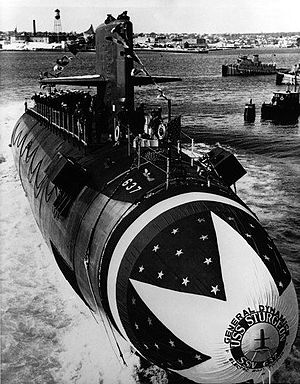
The Sturgeon class (known colloquially in naval circles as the 637 class) was a class of nuclear-powered fast attack submarines (SSN) in service with the United States Navy from the 1960s until 2004. They were the "workhorses" of the Navy's attack submarine fleet throughout much of the Cold War. The boats were phased out in the 1990s and early 21st century, as their successors, the Los Angeles, followed by the Seawolf and Virginia-class boats, entered service.
The Sturgeons were essentially lengthened and improved variants of the Thresher/Permit class that directly preceded them. The five-compartment arrangement of the Permits was retained, including the bow compartment, operations compartment, reactor compartment, auxiliary machinery room no. 2, and the engine room. The extra length was in the operations compartment, including longer torpedo racks to accommodate additional Mark 37 torpedoes, the most advanced in service at the time of the class's design in the late 1950s. The class was designed to SUBSAFE requirements, with seawater, main ballast, and other systems redesigned for improved safety. Because the S5W reactor was used, the same as in the Skipjacks and Thresher/Permits, and the displacement was increased, the Sturgeons' top speed was 26 knots (48Â km/h), 2Â knots slower than the Thresher/Permits. The last nine Sturgeons were lengthened 10 feet (3Â m) to provide more space for electronic equipment and habitability. The extra space also helped facilitate the use of dry deck shelters first deployed in 1982.